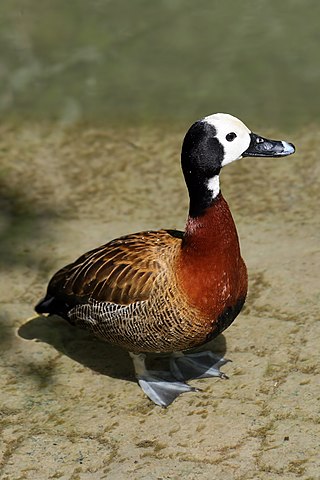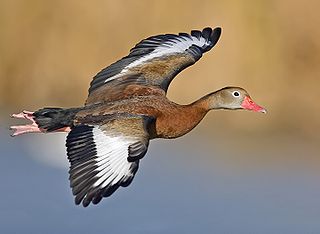
The freckled duck is a waterfowl species endemic to Australia. The freckled duck has also been referred to as the monkey duck or oatmeal duck. These birds are usually present in mainland Australia, but disperse to coastal and subcostal wetlands in the dry period. During such times it is common for the freckled duck population to congregate in flocks in the same area, giving the impression that they are more common than they really are.

The lesser whistling duck, also known as Indian whistling duck or lesser whistling teal, is a species of whistling duck that breeds in the Indian subcontinent and Southeast Asia. They are nocturnal feeders that during the day may be found in flocks around lakes and wet paddy fields. They can perch on trees and sometimes build their nest in the hollow of a tree. This brown and long-necked duck has broad wings that are visible in flight and produces a loud two-note wheezy call. It has a chestnut rump, differentiating it from its larger relative, the fulvous whistling duck, which has a creamy white rump.

The white-faced whistling duck is a whistling duck that breeds in sub-Saharan Africa and much of South America.

The knob-billed duck, or African comb duck, is a duck found in tropical wetlands in Sub-Saharan Africa, Madagascar and the Indian Subcontinent from northern India to Laos and extreme southern China.

The comb duck or American comb duck, is an unusual duck, found in tropical wetlands in continental South America south to the Paraguay River region in eastern Paraguay, southeastern Brazil and extreme northeastern Argentina, and as a vagrant on Trinidad.

The fulvous whistling duck or fulvous tree duck is a species of whistling duck that breeds across the world's tropical regions in much of Mexico and South America, the West Indies, the southern United States, sub-Saharan Africa and the Indian subcontinent. It has plumage that is mainly reddish brown, long legs and a long grey bill, and shows a distinctive white band across its black tail in flight. Like other members of its ancient lineage, it has a whistling call which is given in flight or on the ground. Its preferred habitat consists of wetlands with plentiful vegetation, including shallow lakes and paddy fields. The nest, built from plant material and unlined, is placed among dense vegetation or in a tree hole. The typical clutch is around ten whitish eggs. The breeding adults, which pair for life, take turns to incubate, and the eggs hatch in 24–29 days. The downy grey ducklings leave the nest within a day or so of hatching, but the parents continue to protect them until they fledge around nine weeks later.

The falcated duck or falcated teal is a gadwall-sized dabbling duck from the east Palearctic.

The whistling ducks or tree ducks are a subfamily, Dendrocygninae, of the duck, goose and swan family of birds, Anatidae. In other taxonomic schemes, they are considered a separate family, Dendrocygnidae. Some taxonomists list only one genus, Dendrocygna, which contains eight living species, and one undescribed extinct species from Aitutaki of the Cook Islands, but other taxonomists also list the white-backed duck under the subfamily.

The black-bellied whistling duck, formerly called the black-bellied tree duck, is a whistling duck that before 2000 bred mainly in the southernmost United States, Mexico, and tropical Central to south-central South America. It can be found year-round in much of the United States. It has been recorded in every eastern state and adjacent Canadian province. Since it is one of only two whistling duck species native to North America, it is occasionally just known as the "whistling duck" or "Mexican squealer" in the southern USA.

The spotted whistling duck is a member of the duck family Anatidae. It is also referred to as the "spotted tree duck". This duck resides in Indonesia, New Guinea and the Philippines, but captive populations can be found elsewhere in the world.

The plumed whistling duck, also called the grass whistling duck, is a whistling duck that breeds in Australia. It is a predominantly brown-coloured duck with a long neck and characteristic plumes arising from its flanks. The sexes are similar in appearance.

The wandering whistling duck is a species of whistling duck. They inhabit tropical and subtropical Australia, the Philippines, Borneo, Indonesia, Papua New Guinea and the Pacific Islands.

The white-winged duck or white-winged wood duck is a large species of duck, formerly placed in the genus Cairina with the Muscovy duck and allied with the dabbling ducks. However, mtDNA cytochrome b and NADH dehydrogenase subunit 2 sequence analysis indicate that the anatomical similarity to the Muscovy duck is deceiving and that the species is appropriately placed in a monotypic genus, as Asarcornis scutulata, which is evolutionarily closer to the redhead.

Flamingo Gardens is a 60-acre (24 ha), is a botanical garden and wildlife sanctuary, located just west of Fort Lauderdale, Florida and north of Miami at 3750 South Flamingo Road, Davie, Florida, United States. It is open to the public for a fee.

The Pantanos de Centla are wooded wetlands along the coast in state of Tabasco in Mexico. They have been protected since 2006 with the establishment of the Pantanos de Centla Biosphere Reserve. It is also a World Wildlife Fund ecoregion.

The wildlife of Nigeria consists of the flora and fauna of this country in West Africa. Nigeria has a wide variety of different habitats, ranging from mangrove swamps and tropical rainforest to savanna with scattered clumps of trees. About 290 species of mammal and 940 species of bird have been recorded in the country.

Queen Elizabeth II Botanic Park is a non-profit outdoor garden and wildlife facility located in the North Side District of Grand Cayman Island in the British West Indies. The park is owned jointly by the Cayman Islands Government and the National Trust for the Cayman Islands, a group dedicated to preserving natural environments and places of historic significance in the Cayman Islands. Opened in 1994 with only the Woodland Trail completed, the park now also contains the Floral Colour Garden, a Cayman Heritage Garden, a lake, an orchid boardwalk exhibit, and a Blue Iguana Habitat. Also inside the park is a gift shop and a visitor's interpretive center, the starting point from which visitors can enter the Woodland Trail and other garden grounds.

The Guianan mangroves (NT1411) is a coastal ecoregion of southeastern Venezuela, Guyana, Suriname, French Guiana and Brazil. The mangroves provide an important habitat for migrating birds that winter in the area. Large areas are intact, although they are threatened by destruction of the trees for timber and to make way for agriculture, and from upstream agricultural and industrial pollution.

Ceiba State Forest, also referred to as the Ceiba State Reserve, is a mangrove forest and nature reserve located in the eastern coast of Puerto Rico, in the municipalities of Ceiba and Fajardo. The forest extends over 350 acres and is mostly made of mangrove forests which are habitat to a large number of bird species. Although named Ceiba State Forest, the forest is not home to the large ceiba tree, and it is actually named after the municipality it is located in. In addition to the mangrove forests, the reserve also includes coastal zones that comprise sandy beaches and coral reefs found in both the Ceiba and Fajardo sections.





















